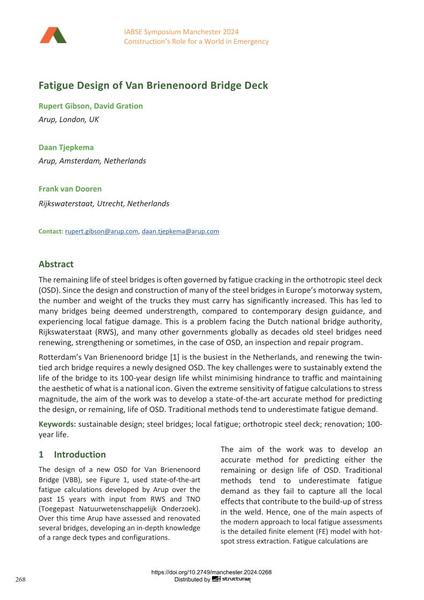Fatigue Design of Van Brienenoord Bridge Deck

|
|
|||||||||||
Bibliografische Angaben
| Autor(en): |
Rupert Gibson
(Arup, London, UK)
David Gration (Arup, London, UK) Daan Tjepkema (Arup, Amsterdam, Netherlands) Frank van Dooren (Rijkswaterstaat, Utrecht, Netherlands) |
||||
|---|---|---|---|---|---|
| Medium: | Tagungsbeitrag | ||||
| Sprache(n): | Englisch | ||||
| Tagung: | IABSE Symposium: Construction’s Role for a World in Emergency, Manchester, United Kingdom, 10-14 April 2024 | ||||
| Veröffentlicht in: | IABSE Symposium Manchester 2024 | ||||
|
|||||
| Seite(n): | 268-276 | ||||
| Anzahl der Seiten (im PDF): | 9 | ||||
| DOI: | 10.2749/manchester.2024.0268 | ||||
| Abstrakt: |
The remaining life of steel bridges is often governed by fatigue cracking in the orthotropic steel deck (OSD). Since the design and construction of many of the steel bridges in Europe’s motorway system, the number and weight of the trucks they must carry has significantly increased. This has led to many bridges being deemed understrength, compared to contemporary design guidance, and experiencing local fatigue damage. This is a problem facing the Dutch national bridge authority, Rijkswaterstaat (RWS), and many other governments globally as decades old steel bridges need renewing, strengthening or sometimes, in the case of OSD, an inspection and repair program. Rotterdam’s Van Brienenoord bridge [1] is the busiest in the Netherlands, and renewing the twin- tied arch bridge requires a newly designed OSD. The key challenges were to sustainably extend the life of the bridge to its 100-year design life whilst minimising hindrance to traffic and maintaining the aesthetic of what is a national icon. Given the extreme sensitivity of fatigue calculations to stress magnitude, the aim of the work was to develop a state-of-the-art accurate method for predicting the design, or remaining, life of OSD. Traditional methods tend to underestimate fatigue demand. |
||||
| Stichwörter: |
orthotrope Stahlfahrbahn Stahlbrücken Nachhaltiges Entwerfen
|
||||
